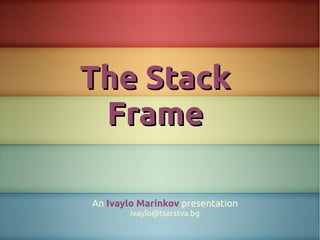
The Stack Frame
- 1. The Stack Frame An Ivaylo Marinkov presentation ivaylo@tsarstva.bg
- 2. Call Stack A stack data structure storing information of a computer program's active subroutines. Whilst important for the software's proper functioning, its details are usually hidden and usage is automated in high-level programming languages.
- 3. Call Stack Purpose Keeping record of the point to which each active subroutine should return control when finished.
- 4. Active Subroutine A routine that has been called but has not finished execution yet. Afterwords, control should be returned to the point where the call has been made. Routines may be nested to any level and recursion is possibe – hence the stack structure.
- 5. For example, the DrawSquare subroutine calls the DrawLine subroutine from four different places. DrawLine must know where to return once completed. This is accomplished by pushing the address following the call instruction – the return address – onto the stack with each call.
- 6. Call Stack Inner Workings The caller pushes the return address onto the stack (winding). The called subroutine, when it finishes, pops the return address off the stack and transfers control to it (unwinding). If a called subroutine calls on yet another subroutine, it will push another address onto the stack, and so on, with the information stacking up and unstacking as the program dictates.
- 7. Should pushing consume all the space allocated for the call stack, an error called stack overflow will occur. There is usually a single call stack associated with each process thread. However, the program may create additional call stacks for tasks such as signal-hadling or cooperative multitasking.
- 8. Additional Call Stack Functions Local data storage – keeping local-scope variable values. Parameter passing – storage for values passed by calling code. Evalution stack – in some cases operands for logical and arithmetic operations may be stored in the call stack. Current instance pointer – for this pointer in object-oriented languages.
- 9. Structure A call stack is composed of stack frames, machine and application banary interface- dependant data structures containing subroutine state information.
- 10. The Stack Frame Generally speaking, a procedure's stack frame contains all the information necessary to save and restore the state of the procedure.
- 11. Strictly speaking, it is only necessary for the calling program and the called procedure to agree on the structure of the stack frame for each procedure call. However, the specification of a calling convention facilitates the use of procedure libraries by defining the structure of the stack frame uniformly for all procedure calls.
- 12. The frame pointer is stored in register $30, also known as $fp. A stack frame consists of the memory on the stack between the frame pointer and the stack pointer. Three steps are necessary to call a Calling convention used in the MIPS architecture stack frame procedure.
- 13. 1. Pass the arguments. The first four arguments are passed in registers $a0-$a3. The remaining arguments are pushed onto the stack. 2. Save the caller-saved registers. This includes registers $t0-$t9, if they contain live values at the call site. The endless MIPS 3. Execute a jal instruction. cycle
- 14. 1. Pass the arguments. The first four arguments are passed in registers $a0-$a3. The remaining arguments are pushed onto the stack. 2. Save the caller-saved registers. This includes registers $t0-$t9, if they contain live values at the call site. The endless MIPS 3. Execute a jal instruction. cycle
- 15. Within the called routine, the following steps are necessary: 1. Establish the stack frame by subtracting the frame size from the stack pointer. 2. Save the callee-saved registers in the frame. Register $fp is always saved. Register $ra and registers $a0-$a3 need to be saved if they are in use and the routine itself makes calls. Any of the registers $s0- $s7 that are used by the callee need to be saved. 3. Establish the frame pointer by adding the stack frame size to the address in $sp.
- 16. To return from a call, a function places the returned value into $v0 and executes the following steps: 1. Restore any callee-saved registers that were saved upon entry. 2. Pop the stack frame by subtracting the frame size from $sp. 3. Return by jumping to the address in register $ra.
- 17. Debugging The purpose of a debugger such as GDB (gnu.org/software/gdb) is to allow you to see what is going on “inside” another program while it executes--or what another program was doing at the moment it crashed.
- 18. In Practice An illustration to viewing the call stack using GDB. 1. Compile your program with the -g option, like cc -g -o p1 p1.c
- 19. 2. Navigate to your program's directory and run GDB: gdb your_program If all went fine, you will land on a command prompt.
- 20. 3. Then install some breakpoints using the break command: break function_name 4. Now run. The program will proceed until the first breakpoint.
- 21. You can select a frame using the frame n command and view frame information using the info frame n command. Some of the details this command displays are the addresses of the frame, the next frame down (called by this frame) and the next frame up (caller of this frame).
- 22. View the call stack using the backtrace command. A backtrace is a summary of how your program got where it is. It shows one line per frame, for many frames, starting with the one currently in execution (frame zero), followed by its caller (frame one), and on up the stack.
- 23. Resources https://en.wikipedia.org/wiki/Call_stack http://www.cs.uaf.edu/~cs301/notes/Chapter9/node11.html http://chortle.ccsu.edu/assemblytutorial/Chapter-26/ass26_4.html http://www.chemie.fu-berlin.de/chemnet/use/info/gdb/ http://www.freebsd.org/doc/en/books/developers-handbook/debugging.html https://www.gnu.org/software/gdb/ Background images from various sources. This presentation was created using only free and open source software including the Ubuntu Linux operating system, LibreOffice, Mozilla Firefox, Geany, GDB and KolourPaint.